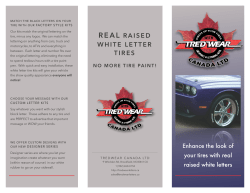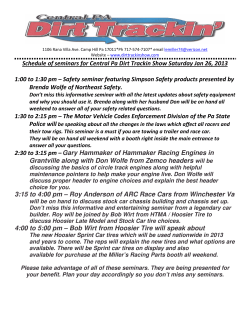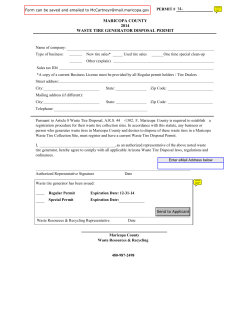
Document 111003
IJhe tire and rubber industry: &’ Leading a ¿lynamic lifecycle by ITRA’s Tire and Rubber Recycling Advisory Council v DUK7 i>’ T he market capacity for scrap tire products is catching up with processing volumes. Substantial investments have been made, especially in the past decade, to recover and utilize scrap tires and other rubber products. This recycling industry will continue to grow. This article, which was prepared by the Tire and Rubber Recycling Advisory Council of the Intemational Tire and Rubber Association (Louisville, Kentucky), describes the current status of tire and rubber recycling. Details regarding TRRAC are provided in a sidebar. Lifecycle assessment important To fully understand the current status of tire and rubber recycling, we must first understand the lifecycle of the materials and products involved, up to the point where the recycling process begins. This is portrayed in the accompanying box. In the first part of the lifecycle, the players are largely rubber producers (virgin or synthetic), rubber users (tire manufacturers, hose and gasket producers, etc.), equipment manufacturers who use rubber products (carmakers, agricultura1 equipment manufacturers, etc.) and product distributors (tire retailers, automotive supply houses, etc.). The rubber products are then used by consumers, either as tires on our cars, as gaskets sealing our doors and Windows, or in balls with which we play. These products, due to the resilience of rubber, normahy have a fair- m Resource Recycling March 1998 ly long use cycle. So, in terms of time elapsed, this is the longest stage of the rubber products lifecycle. The scrap and recycling cycle Once the product has reached the end of its useful life, it enters the scrap and recycling stream. As seen in the accompanying box, this is a multi-stage progression. Clearly, the players in the disposition and recycling of-scrap rubber or tires are scrap generators, state and local govemments, collectors, processors and end users. Since tires represent the vast majority of rubber scrap, we will look at the players from a scrap tire perspective, with the understanding that the dynamics for other forms of scrap rubber are similar. Generators Scrap tires are commonly generated when new tires are purchased to replace used ones. Because most of us buy new tires from dealers, the scrap tire generally becomes the dealer’s responsibility. Depending on state law, the dealer may charge a fee or tax to compensate the firm or the state for tire management costs. Documentation and certification forms for tracking purposes are usually required to validate that the dealer generated these scrap tires through new-tire sales. The dealer will normally contract with a collector to pick up and haul the tires to an approved processor. Before tires are received by the processor, the dealer and/or the collector may sort them to cull out tires that can be resold as used tires or as retreadable casings. Government Due to the large volume of materia1 represented by scrap tires, most states have adopted laws that regulate and manage the scrap tire flow. The typical state program has four components. Funding. As noted above, a fee or tax is charged on the sale of a new tire to fund scrap tire managementand disposal efforts (30 states impose a fee). The fee or tax is generally added to the sale price of the new tire, and the funds are sent to and managed by the state. The funds typically flow back to processors or counties as reimbursements for the costs of properly managing tires, or are used in some form to reimburse end users to promote increased use of tire-derived materials. Permitting and licensing. The state govemment imposes permit or license requirements on collectors, processors and disposition sites (such as tire monofills). These requirements are normally structured to minimize the state’srisk of having to clean up tire piles or residues left by a defunct collector or Tkacking. Dealers, collectors and processors (or disposition site operators) use tracking forms to validate the legitimacy of the flow; the forms become the basis for funding. These forms require the generator (commonly a dealer) to certify the amount of tires and how the tires were generated. Then the collector and processor must validate or confirm those facts. Enforcement. State enforcement personnel inspect and audit tire dumps, collection sites, processing facilities and disposition sites to ensurethat scrap tire flow is being managed appropriately. Their audits cover all the parametersof the stíite’s specific scrap tire management law and the individual permit involved. These personnelgenerally have the authority to write violation notices and to start penalty proceedings. Additional programs. Some states also fund and manage scrap tire pile clean-up actions where large piles exist and no obvious funding or plan is in place to manage or disposeof them. Additionally, more and more states are using mechanisms, such as grants and other sources of funding, for the development of markets for scrap-tire-derived materials or products. (/ the virgin rubber plant is harvested (/ the plant is processed or synthetic rubber is produced (/ rubber is vulcanized as part of a product manufacturing process c/ finished rubber products are made (tires, hoses, gaskets, etc.) c/ the nroducts are sent throuah distribution channels for consum& purchase d rubber products are used u’ defective parts and products are scrapped d tbe products rea& the end of th& useful Efe. processor. The requirements include site plans, turnover requirements (e.g., 75 percent of material received in one year must leave the site orbe disposed of properly), storage limits and financia1 assurances. Collectors Many tire collectors are local used tire sellers who contract with tire dealers to remove tires for a fee. The collector then sorts the (/ rubber products enter the scrap or recycling stream i/ state and local governments regulate the scrap flow (/ collectors pick up products, sort them for recycling and take them to processors or landfílls ti landfills bury the products, or processors reduce their size before recycling or landtilling, or retreaders make new tires from a used ones d recycling processorsclean, separateand package recovered materials for sale d energy producers burn tire-derived fuel, oí civil engineering users employ chips ti crumb rubber is modi&ed with a surface treatment for higher-vah,te applications ti end users (generally also users of virgm rubber) purchase treated or untreated rubber for recycling li/ recycled robber is used. tires and takes those that cannot be resold to a processor. GET THE STEEL OUT OF YOUR bi SCRAP TIRES FAST! H EAGLE TIRE DEBEADER r Unique Patented Cutter System Pulls both beads from auto & semi-truck tires without precutting the beads. With a 20 sec. cvcle you may process up tó 75 v * Produces Cleanest TDF Available * Stationary Least Expensive to Operate l idura Max’s unique cutter design, unlike tok type cutters, allows tires to be sheared instead of kped. As a result, the shredded material has no protruding res, making it easier to handle. These units also operate approximately 112 the cost of other brand tire lredders. Call us for your tire lredding needs. -- ndurz Circle 47 on RR service card m Resource Recycling March 1998 Call g&$@~‘~~ 4444 So. York Street, Sioux City, IA Ph: l-800-755-8473, Fax l-71 2-255-9239 http://www.vitalsite.com/recycle/tires E-mail: tirecut@pionet.net Circle 296 on RR service card DAWNINGOF A NEW ERA This article was excerpted in part from TRRAC’s new informational brochure, Understanding í%-eand Rubber Recycling, which is being released this spring. TRRAC is an eight-member council established by ITRA in 1995 to assist, educate and serve as spokespeopie for the association’stVe and recycling membership and the industry at large. Regional and national collectors also operatein the market. Because the used tire market is fairly large, especially for export, these l%rr~s can collect vast numbers of resellable tires efficiently. They also fil1 a need of large tire dealership chains who do not want each store having to manage its own scrap tire flow. Processors Many scrap tire processorsare also big players in the collection market. To ensure the proper management of their input volume and to improve the revenue picture, most processorsstill rely heavily on tipping fee income. Leaving the collection business to third parties may leave the processor without a guaranteed flow of tires and with tires delivered at lower tipping fees. In addition, the used tire and casing business represents income potential. Processors who are not also collectors find they receive loads that have already been culled, leaving them with little orno used tire revenue. As recently as five years ago, the processingindustry was extremely fragmented. However, since then significant consolidation has occured, and most industry members are experienced and profes- nual Conferencé Trade Show of the Washington Recycling Association and State May 3-6, 1998 Yakima Convention Center Yakima, Washington For additional information, contact: WSRA (206) 244-0311 L Circle 166 on RR service card TC-6 Oil Filter Crusher Crushes with 22,000 Ibs. of pressure. Handles filters up to 5” wide and 8” high: ITI trwk tires into quaiterr Available in 3 different models 1. Wall Hang Unit 2. Full Standina on o!Xional 3. %“nf~%~~?!?z oil tank with optional plate. Stand Oitional a gasol~ne M ektr#: mokx, ~tkz witf~a heavyduty box frame mcun&d on a Powared by asar TC-100 Tire Cutter portabla trsulerwith standardT WI hitch. kfydraulii tire lMl makes kwkng and unfoacfing safe and easy Extra heavyduty unit desiam& to cut nger and ttuck tires all belted radials. It ts portable and can easily be moved 10 any location. Priced for affor~Íi¡~~ ~tLS avaitable with a gasolina ar an eiectric motor, and can cut up to 120 passenger tires or 40 truck tires per hour into quarters, tic into 2o”x2O”xW bales. Designec! for mobility. 7’10” long by 24” wtde. Easily fits onto a fru& or traiisr. 12-vott system p&h na hydrauri 0nes) or 1 lO-volt hookup for in-plant operation. ._________ fdv/ &tt passenger and Ighl truck wtteels Whf& fafl tul of tires when crushed PortaMe and fast. Crushes up to 1M1 tires per haur. Extra heavy-cfuty unct cfesigned to proMe years of tfouble-free serwce, yet príced k>w so use* can afford lo plrchase machme Avat&bie w@hgas M eiectric ergme TIRE SERVICEEQUIPMENTMFG.CO. ING. 3451 S. 40th Street l Phoenix, Arizona 85040 INTERNET www.tsissg.com TOLL FREE (6o~~~t%20 (800) 223-4540 (502) i!3?5025 Circle 262 on RR service card Resource Recycling March 1998 m sional in their operations. There are four major categories of processors. Monofills. As regulations have increased and recycling markets have developed, the flow of whole or processedtires into landfills or monofills has decreased. There are, however, still a number of monofills or landfills that receive, shred and bury tires. Increasingly, however, even these processors are entering the recycling market, particularly as chip suppliers to fuel or civil engineering users. Chip markets. The largest-volume markets today are chip markets, with tire-derived fuel (TDF) and civil engineering uses domi- nating. These markets have created a niche for many processors to service, wherein the processor can handle large volumes of tires and se11al1 or most of the material. Crumb rubber. Crumb rubber producers take shredded tire scrap and size reduce it further, while removing al1 the non-rubber components (dirt, steel fiber, etc.). Some tirms specializein crumb rubber production, and othersmake both chips and crumb rubber. Although chips are the largest market segment,many chip producersare moving into crumb rubber production becausethey recognize that their viability in the chip market is largely dependent on tipping fees due to the low value of chips. As tipping fees go down, these firms want to move into the higher>$ue market representedby crumb rubber. Overcapacity has plagued the crumb rubí ber market. As a result of passageof the 1991 federal highway act, which called for the increased use of crumb rubber in highway projects, crumb rubber production capacity rose by 200 to 300 percent. When the usage requirement was repealed, the tire recycling industry was left with excess capacity. The result has been consolidation in the industry and the opportunity for crumb-rubber end users to discriminate in their purchasesbased on quality and price. Prices have, therefore, been depressed,making it harder for processors to be profitable. The prognosis for crumb rubber producers looks positive, however, as more and more research and development is being done to allow the use of crumb rubber in rubber products. The automotive and tire industries are particularly aggressive in this effort. Integrated Iirms. Some processorsmake crumb rubber and then use tbe rubber to make products. This is currently the smallest market segment, but one with enormous growth potential. The growth will come as consolidation of the industry continues and processors realize that the best opportunity to make a profit is in end-use product manufacturing. We also may see some current or future end users integrate downward into the processing businessto better control quality and price. ETTHE CHIPS FALL... Let’s faceit. In the scraptire processinggame,chip sizeis everything.So why gamble?Count on SSI’s reputation for delivering reliable, cost-effective, productiveand easy-to-usetire shreddingsystems that put the big chips in your bank account. n Consistent 1”-2”TDF Chipsn RougbShredn Crumb Rubber Preprocessingn Passenger, ‘Iìuck or OffRoadTiresn Mobile & StationarySystems W New & UsedEquipment.Cal1SSZtoday. srllllf People, Systems, Solutions. Circle 179 on RR service card m Resource Recycling March 1998 End users The most important and least developed part of the industry is the end-user sector. The key to increasing the use of scrap-tire materials is in the development of new end-use applications and the increased use of these materials in existing applications. For example, rubber use is growing because of the introduction of new technologies that modify raw crumb rubber by surface treatment or devulcanization to expand its use into highervalue applications. Today’s big players in the end-use sector are tire manufacturers; state transportation agencies; power generators and cement and paper producers that use TDF; and manufacturers of rubber products, such as mats, solid wheels, friction brakes and other industrial, agricultura1 and automotive rubber products. Driven by improved markets and concerted govemment action, more scrap tires are being recoveredthan ever before. In severalregions of the country, tires in stockpiles have been processed and used in practical, cost-saving applications. Gradually, market capacity is catching up with processing volumes. As thesetrends continue, the tire and rubber recycling industry will continue to use its energy, technologies and financia1 resources to create the best possible end results for the mateRR rial.
© Copyright 2025













